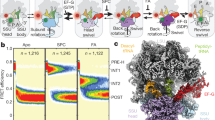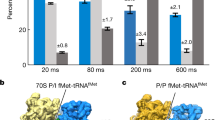Abstract.
The elongation and termination steps of protein synthesis are controlled by elongation and release factors, respectively. Elongation factors deliver the aminoacyl tRNA to the ribosomal A site, ensuring the elongation of the nascent polypeptide chain by one amino acid at a time, while release factors recognize the stop codons and trigger the release of the polypeptide from the ribosome. Recently, highresolution crystal structures of ribosomes as well as translation factors on and off the ribosome have contributed a great deal to our understanding of the molecular basis of protein synthesis. This review concentrates on recent developments in our understanding of the elongation and termination steps of protein synthesis, particularly the roles of translation factors and their similarities and differences in the eukaryotic cytosol and prokaryotic systems, through a combination of structural and biochemical studies.
Similar content being viewed by others
Author information
Authors and Affiliations
Corresponding author
Additional information
Received 25 October 2007; received after revision 5 December 2007; accepted 7 December 2007
Rights and permissions
About this article
Cite this article
Noble, C.G., Song, H. Structural studies of elongation and release factors. Cell. Mol. Life Sci. 65, 1335–1346 (2008). https://doi.org/10.1007/s00018-008-7495-6
Published:
Issue Date:
DOI: https://doi.org/10.1007/s00018-008-7495-6




